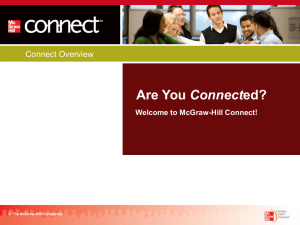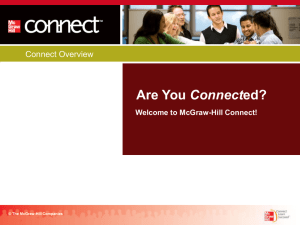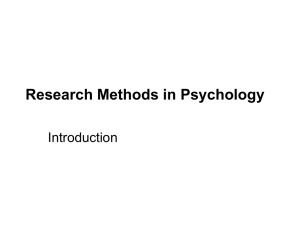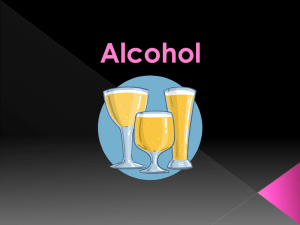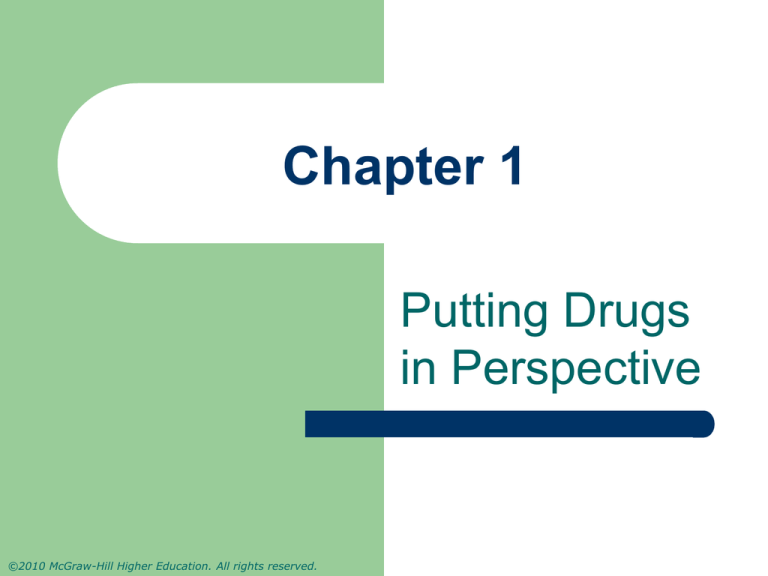
Chapter 1
Putting Drugs
in Perspective
©2010 McGraw-Hill Higher Education. All rights reserved.
The Myths of a Simple Solution
“Just Say No”
–
–
Simplistic view of a complicated problem
“Any solution to a complex problem that is simple, is
usually wrong.” – HL Menken
What is the best way to engage and motivate
those dependent on drugs?
©2010 McGraw-Hill Higher Education. All rights reserved.
Failed Approaches
Scare tactics
–
Example: 1936 Reefer madness
1960s “War on Drugs”
Drug-specific approaches to curb interest
–
Reverse effect: providing credible drug-specific
information heightened curiosity and alleviated fears
rather than reducing use resulting in increased drug
use
©2010 McGraw-Hill Higher Education. All rights reserved.
Minimizing Alcohol Abuse
‘Excessive alcohol consumption is the 3rd
leading preventable cause of death in the US
and is associated with multiple adverse health
consequences (Centers for Disease Control,
2004)
©2010 McGraw-Hill Higher Education. All rights reserved.
Alcohol-Related Problems
Binge Drinking on College Campuses
40-45% of college students binge drink, according to
the Harvard School of Public Health
Approximately 1,400 students die each year of alcoholrelated incidents
At least half of the sexual assaults on college
campuses involve alcohol consumption by the
perpetrator, the victim, or both
The first 6 weeks are the most dangerous
©2010 McGraw-Hill Higher Education. All rights reserved.
Significant Negative Effects
See Chart on page 8
Academic problems
Property damage
Death
Driving under the
influence
©2010 McGraw-Hill Higher Education. All rights reserved.
Sexual assault and rape
Personal injury
High-risk sexual behavior
Other high-risk behaviors
Anger, violence, road
rage
Intimate Partner Violence (IPV)
Alcohol involved in 20-25% of IPV (Intimate Partner Violence)
See Chart on page 9
Alcohol caused:
impaired judgment
cognitive impairment
loosened inhibitions
physical effects that lead to IPV
exacerbation of marital/couples conflicts
negative family life, increasing violence
Drinking by men – stronger predictor of IPV than drinking by
women
©2010 McGraw-Hill Higher Education. All rights reserved.
Drinking and Driving – Young
Drivers
Traffic fatalities 29% DUI (in 2002) – drivers 15-20
years of age
21% (in 2002 and 2003) reported DUI (aged 16-20) in
last year
Factors contribute to young drivers crashes:
Lack of driving experience
Overconfidence
Other teenagers in the car (encouraging risky driving)
©2010 McGraw-Hill Higher Education. All rights reserved.
Intentional & Unintentional Deaths
– Other than Traffic Fatalities
45% of fatalities other than traffic fatalities
related to drinking (under the age of 21) were:
–
Drowning, burns, falls, alcohol overdose and related
deaths, etc.
Intentional deaths related to alcohol include
homicides and suicides
–
12% of male and 8% of female suicides are related
to alcohol
©2010 McGraw-Hill Higher Education. All rights reserved.
Other Problems in Perspective
Tobacco – the most deadly drug
–
25% of the population of smokers, many of those in
recovery from alcohol/drugs will die of smokingrelated illnesses
Continued emphasis on supply side & neglect
of the demand side of the drug problem
Racist approach to the drug problem (the
issues of people of color are often ignored)
Socioeconomic inequities that undermine the
American dream
©2010 McGraw-Hill Higher Education. All rights reserved.
Problems – cont’d
Academic (school and college) inadequacies &
inequities failure to motivate & educate young
people are a major part of the problem
Denial of alcohol/drug problems in the family
Student drug use – a continued concern
Adolescent co-occurring disorders
©2010 McGraw-Hill Higher Education. All rights reserved.
The 5 Major Perspectives (p. 18-21)
The Moral-Legal Perspective
The Medical-Health Perspective
The Psycho-Social Perspective
The Social-Cultural Perspective
The Spirituality Perspective
©2010 McGraw-Hill Higher Education. All rights reserved.
The Moral-Legal Perspective
Viewpoint: Law Enforcement & Criminal Justice
Systems
Major Focus: “Keep specific drugs away from
people.”
Approach: Reduce availability of drugs, Punish
as a deterrent
Drawback: Addresses on the supply side
©2010 McGraw-Hill Higher Education. All rights reserved.
The Medical-Health Perspective
Viewpoint: Medical and Health Treatment
Fields
Major Focus: “Drug/alcohol use as a public
health problem.”
Approach: Treatment focuses on physical
damage
Drawback: Assumes – health info influences
attitudes, beliefs, habits, addiction
©2010 McGraw-Hill Higher Education. All rights reserved.
The Psycho-Social Perspective
Viewpoint: Mental Health and Alcohol/Drug
Treatment Fields
Major Focus: Prevent, intervene and treat
alcohol/drug & co-occurring disorders
Approach: Provide services from housing,
finances, to quality of life
Drawback: Public agencies are underfunded,
understaffed, problems are many and at times
overwhelming
©2010 McGraw-Hill Higher Education. All rights reserved.
The Social-Cultural Perspective
Viewpoint: Social agencies and institutions
Major Focus: Assumption – alcohol/drug abuse
is due to frustration and hopelessness with
people’s lives
Approach: Adapt the environment to meet the
individual’s needs
Drawback: Poorly funded and societal change
is slow
©2010 McGraw-Hill Higher Education. All rights reserved.
The Spiritual Perspective
Viewpoint: Many different groups including the
Anonymous organizations (e.g., AA, NA, CoDA)
Major Focus: Drug use is ‘an emptiness and spiritual
void that requires spiritual healing”
Approach: Conservative religious beliefs & attending
traditional or nontraditional religious services, private
prayer, meetings. Having one´s own definition of
spirituality
Drawback: Watching or listening instead of
participating
©2010 McGraw-Hill Higher Education. All rights reserved.







